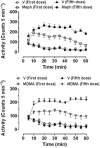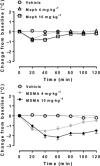The preclinical pharmacology of mephedrone; not just MDMA by another name
- PMID: 24654568
- PMCID: PMC3997268
- DOI: 10.1111/bph.12628
The preclinical pharmacology of mephedrone; not just MDMA by another name
Abstract
The substituted β-keto amphetamine mephedrone (4-methylmethcathinone) was banned in the UK in April 2010 but continues to be used recreationally in the UK and elsewhere. Users have compared its psychoactive effects to those of 3,4-methylenedioxymethamphetamine (MDMA, 'ecstasy'). This review critically examines the preclinical data on mephedrone that have appeared over the last 2-3 years and, where relevant, compares the pharmacological effects of mephedrone in experimental animals with those obtained following MDMA administration. Both mephedrone and MDMA enhance locomotor activity and change rectal temperature in rodents. However, both of these responses are of short duration following mephedrone compared with MDMA probably because mephedrone has a short plasma half-life and rapid metabolism. Mephedrone appears to have no pharmacologically active metabolites, unlike MDMA. There is also little evidence that mephedrone induces a neurotoxic decrease in monoamine concentration in rat or mouse brain, again in contrast to MDMA. Mephedrone and MDMA both induce release of dopamine and 5-HT in the brain as shown by in vivo and in vitro studies. The effect on 5-HT release in vivo is more marked with mephedrone even though both drugs have similar affinity for the dopamine and 5-HT transporters in vitro. The profile of action of mephedrone on monoamine receptors and transporters suggests it could have a high abuse liability and several studies have found that mephedrone supports self-administration at a higher rate than MDMA. Overall, current data suggest that mephedrone not only differs from MDMA in its pharmacological profile, behavioural and neurotoxic effects, but also differs from other cathinones.
Keywords: 5-hydroxytryptamine; MDMA; body temperature; cathinones; dopamine; drug metabolism; locomotion; mephedrone.
© 2014 The British Pharmacological Society.
Figures





Similar articles
-
Differential effects of cathinone compounds and MDMA on body temperature in the rat, and pharmacological characterization of mephedrone-induced hypothermia.Br J Pharmacol. 2013 Feb;168(4):966-77. doi: 10.1111/j.1476-5381.2012.02236.x. Br J Pharmacol. 2013. PMID: 23043631 Free PMC article.
-
Mephedrone, compared with MDMA (ecstasy) and amphetamine, rapidly increases both dopamine and 5-HT levels in nucleus accumbens of awake rats.Br J Pharmacol. 2011 Dec;164(8):1949-58. doi: 10.1111/j.1476-5381.2011.01499.x. Br J Pharmacol. 2011. PMID: 21615721 Free PMC article.
-
Behavioural and neurochemical comparison of chronic intermittent cathinone, mephedrone and MDMA administration to the rat.Eur Neuropsychopharmacol. 2013 Sep;23(9):1085-95. doi: 10.1016/j.euroneuro.2012.09.005. Epub 2012 Oct 7. Eur Neuropsychopharmacol. 2013. PMID: 23051939
-
Mephedrone and MDMA: A comparative review.Brain Res. 2020 May 15;1735:146740. doi: 10.1016/j.brainres.2020.146740. Epub 2020 Feb 19. Brain Res. 2020. PMID: 32087112 Review.
-
Predicting the Abuse Liability of Entactogen-Class, New and Emerging Psychoactive Substances via Preclinical Models of Drug Self-administration.Curr Top Behav Neurosci. 2017;32:145-164. doi: 10.1007/7854_2016_54. Curr Top Behav Neurosci. 2017. PMID: 27909988 Review.
Cited by
-
New psychoactive substances: Pharmacology influencing UK practice, policy and the law.Br J Clin Pharmacol. 2020 Mar;86(3):445-451. doi: 10.1111/bcp.14209. Epub 2020 Feb 4. Br J Clin Pharmacol. 2020. PMID: 31917863 Free PMC article. Review.
-
Synthesis, characterization and monoamine transporter activity of the new psychoactive substance mexedrone and its N-methoxy positional isomer, N-methoxymephedrone.Drug Test Anal. 2017 Mar;9(3):358-368. doi: 10.1002/dta.2053. Epub 2016 Sep 21. Drug Test Anal. 2017. PMID: 27524685 Free PMC article.
-
Phase I metabolites of mephedrone display biological activity as substrates at monoamine transporters.Br J Pharmacol. 2016 Sep;173(17):2657-68. doi: 10.1111/bph.13547. Epub 2016 Jul 31. Br J Pharmacol. 2016. PMID: 27391165 Free PMC article.
-
4-Isobutylmethcathinone-A Novel Synthetic Cathinone with High In Vitro Cytotoxicity and Strong Receptor Binding Preference of Enantiomers.Pharmaceuticals (Basel). 2022 Nov 30;15(12):1495. doi: 10.3390/ph15121495. Pharmaceuticals (Basel). 2022. PMID: 36558946 Free PMC article.
-
Effect of Some Psychoactive Drugs Used as 'Legal Highs' on Brain Neurotransmitters.Neurotox Res. 2016 Apr;29(3):394-407. doi: 10.1007/s12640-015-9569-1. Epub 2015 Oct 26. Neurotox Res. 2016. PMID: 26501352 Free PMC article.
References
-
- ACMD. 2010. Consideration of the cathinones. Home office report. Available at: http://www.homeoffice.gov.uk/publications/agencies-public-bodies/acmd1/a...(accessed 21/3/2014)
-
- Al-Sahli W, Ahmad H, Kheradmand F, Connolly C, Docherty JR. Effects of methylenedioxymethamphetamine on noradrenaline-evoked contractions of rat right ventricle and small mesenteric artery. Eur J Pharmacol. 2001;422:169–174. - PubMed
Publication types
MeSH terms
Substances
LinkOut - more resources
Full Text Sources
Other Literature Sources
Medical
Miscellaneous

